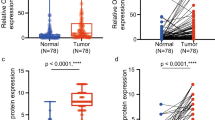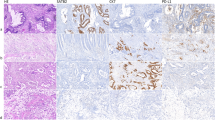Abstract
Colorectal cancer (CRC) is one of the most common gastrointestinal cancers worldwide with high morbidity and mortality rates. The discovery of small molecule anticancer reagents has significantly affected cancer therapy. However, the anticancer effects of these therapies are not sufficient to completely cure CRC. PDZ-binding kinase (PBK) was initially identified as a mitotic kinase for mitogen-activated protein kinase and is involved in cytokinesis and spermatogenesis. Aberrant expression of PBK has been reported to be closely associated with malignant phenotypes of many cancers and/or patient survival. However, the expression of PBK and its association to patient survival in CRC have not been fully elucidated. In the present study, 269 primary CRCs were evaluated immunohistochemically for PBK expression to assess its ability as a prognostic factor. CRC tumor cells variably expressed PBK (range, 0–100%; median, 32%) in the nucleus and cytoplasm. Univariate analyses identified a significant inverse correlation between PBK expression and pT stage (P<0.0001). Furthermore, patients carrying CRC with higher PBK expression showed significantly favorable survival (P=0.0094). Multivariate Cox proportional hazards regression analysis revealed high PBK expression (HR, 0.52; P=0.015) as one of the potential favorable factors for CRC patients. PBK expression showed significant correlation to Ki-67 labeling indices (ρ=0.488, P<0.0001). In vitro, the PBK inhibitor OTS514 suppressed cellular proliferation of CRC cells with PBK expression through downregulation of P-ERK and induction of apoptosis. These results suggest that PBK-targeting therapeutics may be useful for the treatment of PBK-expressing CRC patients.




Similar content being viewed by others
References
Ferlay J, Soerjomataram I, Dikshit R, Eser S, Mathers C, Rebelo M, Parkin DM, Forman D, Bray F (2015) Cancer incidence and mortality worldwide: sources, methods and major patterns in GLOBOCAN 2012. Int J Cancer 136:E359–E386
Rawla P, Barsouk A, Hadjinicolaou AV (2019) Immunotherapies and Targeted Therapies in the Treatment of Metastatic Colorectal Cancer. Med Sci (Basel) 7:83
Abe Y, Takeuchi T, Kagawa-Miki L, Ueda N, Shigemoto K, Yasukawa M, Kito K (2007) A mitotic kinase TOPK enhances Cdk1/cyclin B1-dependent phosphorylation of PRC1 and promotes cytokinesis. J Mol Biol 370:231–245
Gaudet S, Branton D, Lue RA (2000) Characterization of PDZ-binding kinase, a mitotic kinase. Proc Natl Acad Sci U S A 97:5167–5172
Matsumoto S, Abe Y, Fujibuchi T, Takeuchi T, Kito K, Ueda N, Shigemoto K, Gyo K (2004) Characterization of a MAPKK-like protein kinase TOPK. Biochem Biophys Res Commun 325:997–1004
Park JH, Nishidate T, Nakamura Y, Katagiri T (2010) Critical roles of T-LAK cell-originated protein kinase in cytokinesis. Cancer Sci 101:403–411
Yang YF, Pan YH, Cao Y, Fu J, Yang X, Zhang MF, Tian QH (2017) PDZ binding kinase, regulated by FoxM1, enhances malignant phenotype via activation of beta-Catenin signaling in hepatocellular carcinoma. Oncotarget 8:47195–47205
Brown-Clay JD, Shenoy DN, Timofeeva O, Kallakury BV, Nandi AK, Banerjee PP (2015) PBK/TOPK enhances aggressive phenotype in prostate cancer via beta-catenin-TCF/LEF-mediated matrix metalloproteinases production and invasion. Oncotarget 6:15594–15609
Chang CF, Chen SL, Sung WW, et al. (2016) PBK/TOPK Expression Predicts Prognosis in Oral Cancer. Int J Mol Sci 17:1007
Fujibuchi T, Abe Y, Takeuchi T, Ueda N, Shigemoto K, Yamamoto H, Kito K (2005) Expression and phosphorylation of TOPK during spermatogenesis. Develop Growth Differ 47:637–644
Kwon CH, Park HJ, Choi YR, Kim A, Kim HW, Choi JH, Hwang CS, Lee SJ, Choi CI, Jeon TY, Kim DH, Kim GH, Park DY (2016) PSMB8 and PBK as potential gastric cancer subtype-specific biomarkers associated with prognosis. Oncotarget 7:21454–21468
Ohashi T, Komatsu S, Ichikawa D, Miyamae M, Okajima W, Imamura T, Kiuchi J, Kosuga T, Konishi H, Shiozaki A, Fujiwara H, Okamoto K, Tsuda H, Otsuji E (2017) Overexpression of PBK/TOPK relates to tumour malignant potential and poor outcome of gastric carcinoma. Br J Cancer 116:218–226
Ohashi T, Komatsu S, Ichikawa D et al (2016) Overexpression of PBK/TOPK Contributes to Tumor Development and Poor Outcome of Esophageal Squamous Cell Carcinoma. Anticancer Res 36:6457–6466
Gao T, Hu Q, Hu X, Lei Q, Feng Z, Yu X, Peng C, Song X, He H, Xu Y, Zuo W, Zeng J, Liu Z, Yu L (2019) Novel selective TOPK inhibitor SKLB-C05 inhibits colorectal carcinoma growth and metastasis. Cancer Lett 445:11–23
Herbert KJ, Ashton TM, Prevo R, Pirovano G, Higgins GS (2018) T-LAK cell-originated protein kinase (TOPK): an emerging target for cancer-specific therapeutics. Cell Death Dis 9:1089
Yang J, Yuan D, Xing T, Su H, Zhang S, Wen J, Bai Q, Dang D (2016) Ginsenoside Rh2 inhibiting HCT116 colon cancer cell proliferation through blocking PDZ-binding kinase/T-LAK cell-originated protein kinase. J Ginseng Res 40:400–408
Zhao R, Huang H, Choi BY, Liu X, Zhang M, Zhou S, Song M, Yin F, Chen H, Shim JH, Bode AM, Dong Z, Lee MH (2019) Cell growth inhibition by 3-deoxysappanchalcone is mediated by directly targeting the TOPK signaling pathway in colon cancer. Phytomedicine 61:152813
Su TC, Chen CY, Tsai WC, Hsu HT, Yen HH, Sung WW, Chen CJ (2018) Cytoplasmic, nuclear, and total PBK/TOPK expression is associated with prognosis in colorectal cancer patients: A retrospective analysis based on immunohistochemistry stain of tissue microarrays. PLoS One 13:e0204866
Zlobec I, Molinari F, Kovac M, Bihl MP, Altermatt HJ, Diebold J, Frick H, Germer M, Horcic M, Montani M, Singer G, Yurtsever H, Zettl A, Terracciano L, Mazzucchelli L, Saletti P, Frattini M, Heinimann K, Lugli A (2010) Prognostic and predictive value of TOPK stratified by KRAS and BRAF gene alterations in sporadic, hereditary and metastatic colorectal cancer patients. Br J Cancer 102:151–161
Kanda Y (2013) Investigation of the freely available easy-to-use software ‘EZR’ for medical statistics. Bone Marrow Transplant 48:452–458
Inaguma S, Lasota J, Felisiak-Golabek A, Kowalik A, Wang Z, Zieba S, Kalisz J, Ikeda H, Miettinen M (2017) Histopathological and genotypic characterization of metastatic colorectal carcinoma with PD-L1 (CD274)-expression: Possible roles of tumour micro environmental factors for CD274 expression. J Pathol Clin Res 3:268–278
Inaguma S, Riku M, Hashimoto M, Murakami H, Saga S, Ikeda H, Kasai K (2013) GLI1 interferes with the DNA mismatch repair system in pancreatic cancer through BHLHE41-mediated suppression of MLH1. Cancer Res 73:7313–7323
Hanahan D, Weinberg RA (2000) The hallmarks of cancer. Cell 100:57–70
Allegra CJ, Paik S, Colangelo LH, Parr AL, Kirsch I, Kim G, Klein P, Johnston PG, Wolmark N, Wieand HS (2003) Prognostic value of thymidylate synthase, Ki-67, and p53 in patients with Dukes’ B and C colon cancer: a National Cancer Institute-National Surgical Adjuvant Breast and Bowel Project collaborative study. J Clin Oncol 21:241–250
Fluge O, Gravdal K, Carlsen E et al (2009) Expression of EZH2 and Ki-67 in colorectal cancer and associations with treatment response and prognosis. Br J Cancer 101:1282–1289
Palmqvist R, Sellberg P, Oberg A et al (1999) Low tumour cell proliferation at the invasive margin is associated with a poor prognosis in Dukes’ stage B colorectal cancers. Br J Cancer 79:577–581
Peng Y, Wang L, Gu J (2013) Elevated preoperative carcinoembryonic antigen (CEA) and Ki67 is predictor of decreased survival in IIA stage colon cancer. World J Surg 37:208–213
Petrowsky H, Sturm I, Graubitz O, Kooby DA, Staib-Sebler E, Gog C, Köhne CH, Hillebrand T, Daniel PT, Fong Y, Lorenz M (2001) Relevance of Ki-67 antigen expression and K-ras mutation in colorectal liver metastases. Eur J Surg Oncol 27:80–87
Ota A, Hanamura I, Karnan S, Inaguma S, Takei N, Lam VQ, Mizuno S, Kanasugi J, Wahiduzzaman M, Rahman ML, Hyodo T, Konishi H, Tsuzuki S, Ikeda H, Takami A, Hosokawa Y (2020) Novel Interleukin-6 Inducible Gene PDZ-Binding Kinase Promotes Tumor Growth of Multiple Myeloma Cells. J Interf Cytokine Res 40:389–405
Kim DJ, Li Y, Reddy K, Lee MH, Kim MO, Cho YY, Lee SY, Kim JE, Bode AM, Dong Z (2012) Novel TOPK inhibitor HI-TOPK-032 effectively suppresses colon cancer growth. Cancer Res 72:3060–3068
Acknowledgments
We thank Dr. Takeshi Nishiyama (Nagoya City University) for his critical comments on the statistical analyses. We also thank Kazuko Tanimizu and Naoki Igari (Aichi Medical University) and Koji Kato (Nagoya City University) for their assistance on tissue preparation and immunohistochemical staining.
Funding
This work was supported as a part of Grant-in-Aid for Scientific Research (C) (to ShI, 17K08706 and 20K07410).
Author information
Authors and Affiliations
Contributions
AO and ShI: conceived the study; ShI: designed and supervised the overall study; AN-M and ShI: performed histological and statistical analyses, made the figures and tables, and wrote the manuscript; AN-M, KN, MK, HK, AN-I, YN, KW, and ShT: performed molecular experiments; SaI, AK, KeK, and ShI: performed and analyzed immunohistochemical staining; SaI, AK, and KuK: collected and analyzed the clinical data; YH, ShT, KuK, KeK, and SaT: critically reviewed the manuscript. KeK and SaT: provided facilities. All authors have read the final manuscript and gave final approval for the submitted version.
Corresponding author
Ethics declarations
Conflict of interest
The authors declare no competing interests.
Ethics approval
This project was approved by the Institutional Ethical Review Board of Aichi Medical University Hospital.
Additional information
Publisher’s note
Springer Nature remains neutral with regard to jurisdictional claims in published maps and institutional affiliations.
Supplementary Information
ESM 1
(DOCX 12 kb)
Supplementary Figure S1.
Representative images for the measurement of PBK positivity. a to d, Images for cytokeratin AE1/AE3 (a) and PBK (c) immunohistochemistry were converted into black and white image (b and d). Black area was measured by ImageJ software (NIH, Bethesda, MD). PBK positivity was defined as follows: PBK-positive area was divided by cytokeratin AE1/AE3-positive area (%). Bar; 1mm. (PNG 3595 kb)
Supplementary Figure S2.
ROC curve for PBK positivity on the patient death. Cut-off value was defined from the closest point to the left upper side. (PNG 753 kb)
Supplementary Figure S3.
Overall survival of CRC cases according to PBK expression. Kaplan-Meier curves for the patients grouped according to PBK expression levels. The data from The Cancer Genome Atlas (TCGA) was analyzed using UCSC Xena program (https://xena.ucsc.edu/). Note that patients with CRCs expressing PBK at lower levels showed significantly worse overall survival. (PNG 818 kb)
Supplementary Figure S4.
Cell cycle analyses of CRC cells. SW48 and HCT116 cells with colchicine treatment showed cell cycle arrest at M phase. (PNG 1139 kb)
Supplementary Figure S5.
PBK expression in the tumors with or without gene mutation. Note that no significant correlation was detected between PBK expression and KRAS or BRAF mutations. (PNG 1020 kb)
Supplementary Figure S6.
PBK immunohistochemistry in the cell block sections of cultured CRC cells. Immunohistochemical staining using two different anti-PBK antibodies showed similar staining patterns in the cell block sections of cultured CRC cells. Note that PBK expression levels were well correlated to the results of immunoblot analyses (Fig. 3c). Bar; 30μm. (PNG 1051 kb)
Supplementary Figure S7.
PBK immunohistochemistry in the whole FFPE sections. Representative images for the PBK immunohistochemical staining using whole FFPE sections are presented. Note that PBK signals were well detected even in the invasive front. Bar; 3mm. (PNG 2610 kb)
Rights and permissions
About this article
Cite this article
Nagano-Matsuo, A., Inoue, S., Koshino, A. et al. PBK expression predicts favorable survival in colorectal cancer patients. Virchows Arch 479, 277–284 (2021). https://doi.org/10.1007/s00428-021-03062-0
Received:
Revised:
Accepted:
Published:
Issue Date:
DOI: https://doi.org/10.1007/s00428-021-03062-0




